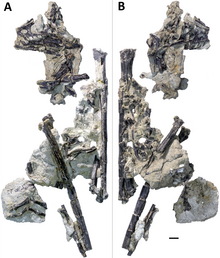Hesperornithoides
Hesperornithoides is a troodontid theropod dinosaur from the Upper Jurassic Morrison Formation of western North America.
| Hesperornithoides Temporal range: Late Jurassic,
~ | |
|---|---|

| |
| Main blocks of the holotype | |
| Scientific classification | |
| Domain: | Eukaryota |
| Kingdom: | Animalia |
| Phylum: | Chordata |
| Clade: | Dinosauria |
| Clade: | Saurischia |
| Clade: | Theropoda |
| Family: | †Troodontidae |
| Genus: | †Hesperornithoides Hartman et al., 2019 |
| Species: | †H. miessleri
|
| Binomial name | |
| Hesperornithoides miessleri Hartman et al., 2019
| |
Discovery
changeThe fossil was found in Wyoming, as the site was carefully documented by the collectors.[1]
Classification
changeA phylogenetic analysis was presented in an abstract in the Journal of Vertebrate Paleontology in 2005. The analysis decided the specimen was a close relative of Sinornithoides.[2]
Significance
changeThis dinosaur is very significant because it is the oldest known troodontid from North America. Until the discovery of Lori, troodontids were believed to have first originated and evolved in Asia and then migrated to North America. Most troodontids were discovered in Asia, and the previously oldest known troodontids, from the Lower Cretaceous, lived there.[3]
References
change- ↑ Lovelace D.M. 2006. An Upper Jurassic Morrison Formation fire-induced debris flow: taphonomy and paleoenvironment of a sauropod (Sauropoda: Supersaurus vivianae) locality, east-central Wyoming. pp. 47–56. In: Foster J.R. and Lucas S.G. (eds) Paleontology and geology of the Upper Jurassic Morrison Formation. New Mexico Museum of Natural History and Science Bulletin 36.
- ↑ Hartman S; Lovelace D. and Wahl W. 2005. Phylogenetic assessment of a maniraptoran from the Morrison Formation. Journal of Vertebrate Paleontology, 25, Supplement to #3, pp 67A-68A [1] Archived 2012-07-26 at the Wayback Machine
- ↑ Hartman, Scott; Mortimer, Mickey; Wahl, William R.; Lomax, Dean R.; Lippincott, Jessica; Lovelace, David M. (2019). A new paravian dinosaur from the Late Jurassic of North America supports a late acquisition of avian flight. PeerJ. 7: e7247. doi:10.7717/peerj.7247.